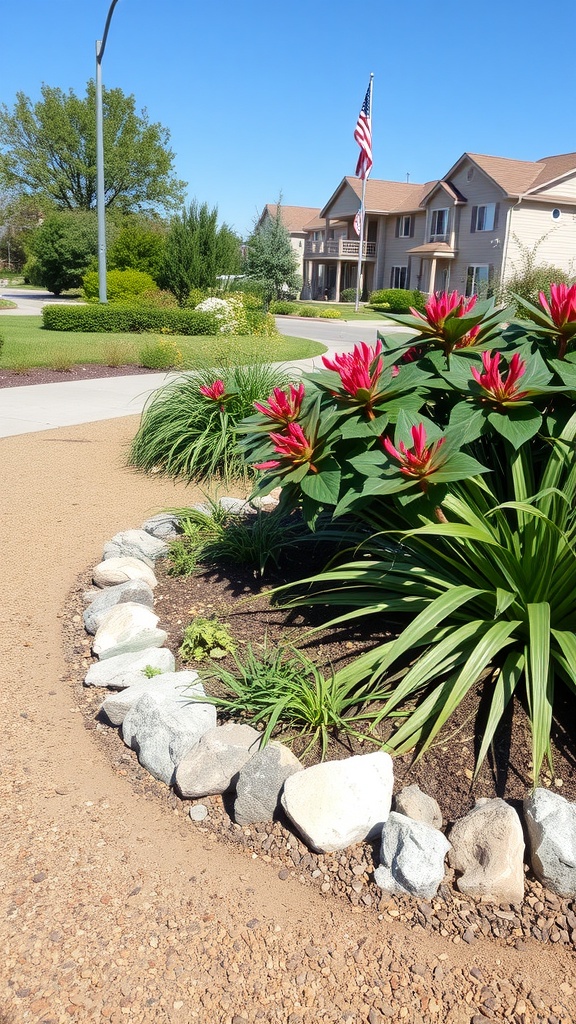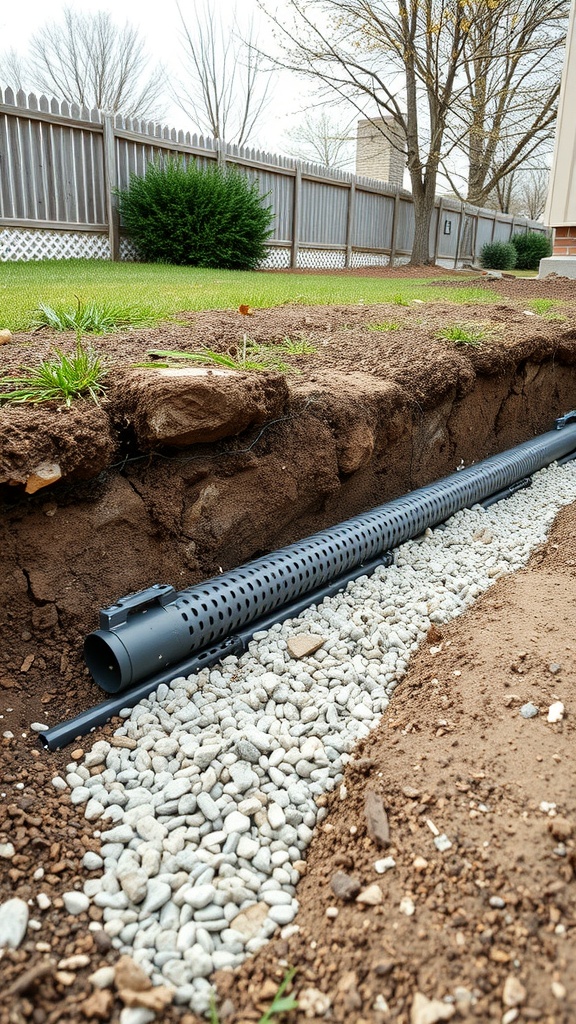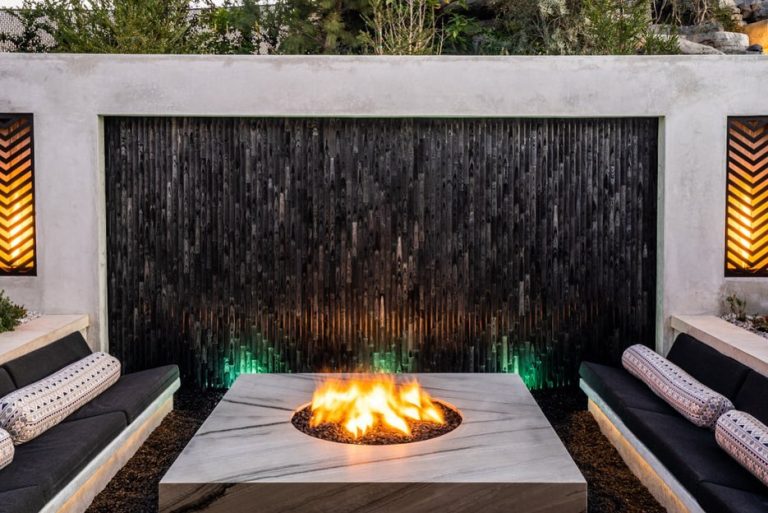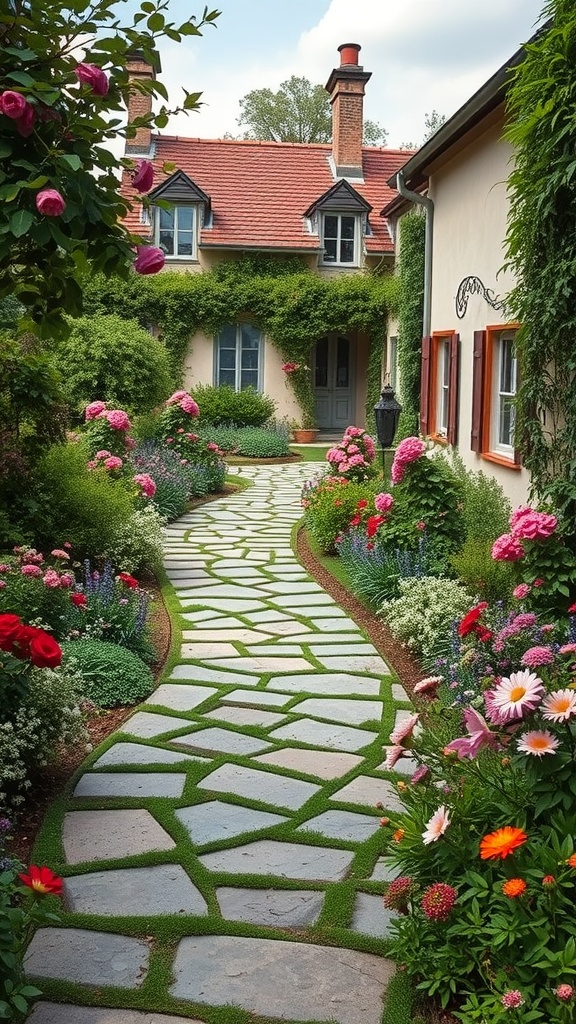13 Creative Dry Rock Bed Ideas for Effective Drainage
When it comes to effective drainage solutions, a dry rock bed can be a simple yet reliable option. This versatile feature helps manage excess water by allowing drainage while maintaining a clean aesthetic in your landscape. Let’s explore 13 practical designs and tips for creating a dry rock bed that not only serves its purpose but also enhances your outdoor space.
Selecting the Right Location
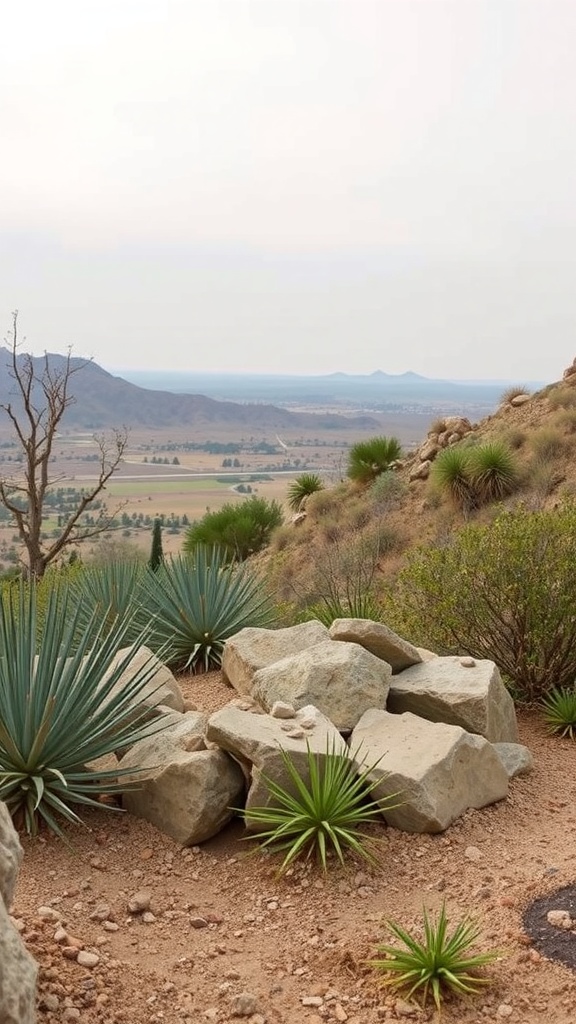
Choosing the right spot for a dry rock bed is key to effective drainage. Look for areas where water tends to pool or flow after heavy rain. This will help direct excess water away from your home or garden.
In the image, you can see a natural landscape with rocky formations and desert plants. This type of environment is ideal for a dry rock bed. The rocks not only provide drainage but also blend beautifully with the surrounding scenery.
Ensure that the location has good sunlight and is away from large trees. Roots can interfere with the drainage system. A clear, open space allows for better water flow and prevents blockages.
Lastly, consider the slope of the land. A slight incline helps water to flow naturally into the rock bed, making it more efficient. With the right location, your dry rock bed will be a practical and attractive addition to your landscape.
Choosing the Appropriate Materials
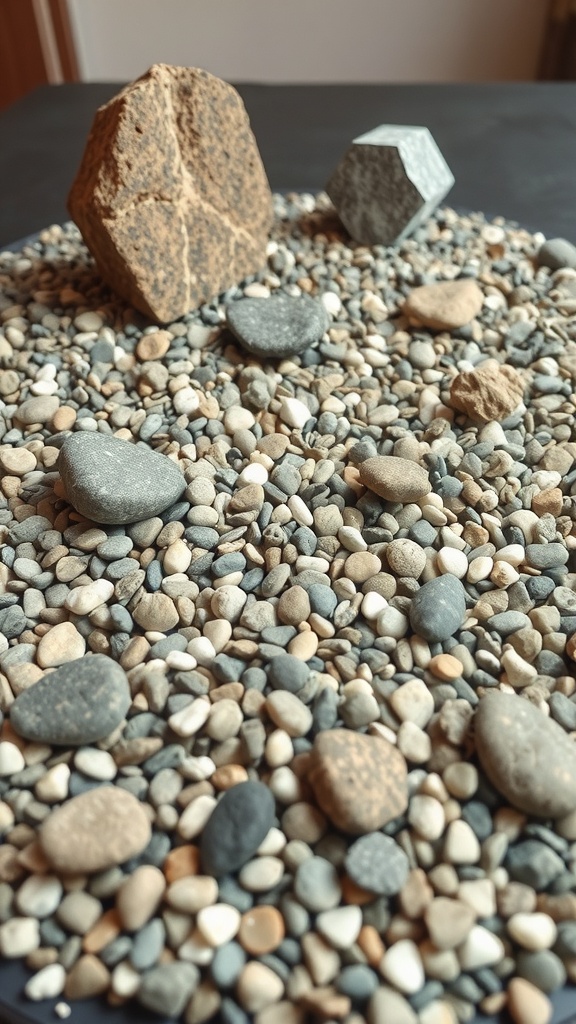
When setting up a dry rock bed for drainage, picking the right materials is key. The image shows a variety of stones and pebbles, each serving a purpose in your drainage system. From larger rocks to smaller gravel, each size plays a role in water flow and filtration.
Using a mix of different stone sizes helps create a stable base. Larger stones can prevent erosion, while smaller pebbles fill in gaps, allowing water to pass through easily. This combination promotes efficient drainage, keeping your landscape dry and healthy.
Consider the color and texture of the stones too. They can enhance the visual appeal of your garden while serving a practical function. A well-chosen rock bed not only looks good but also effectively manages water runoff.
Designing Your Dry Rock Bed
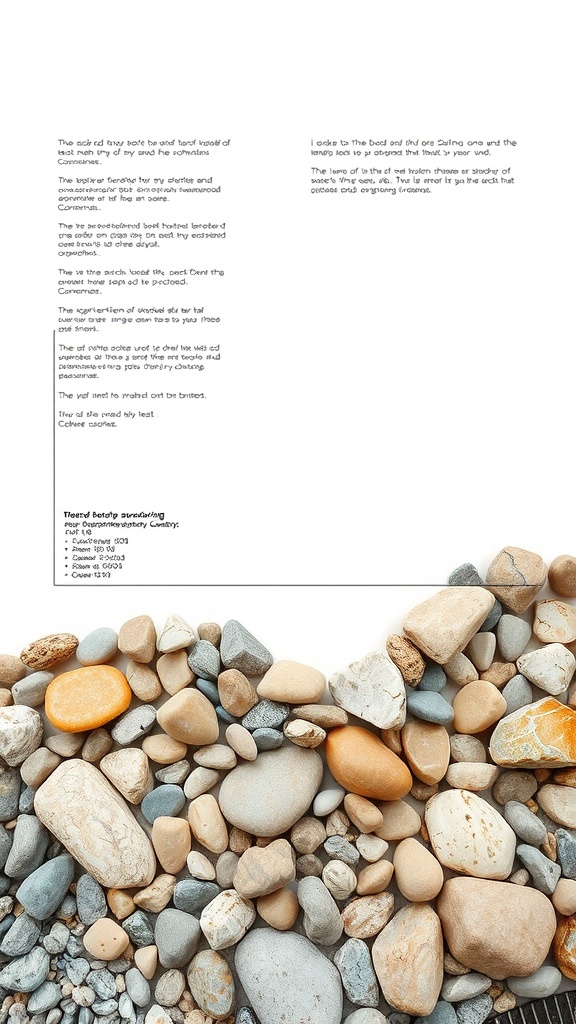
Creating a dry rock bed is a practical and stylish way to manage drainage in your yard. The image shows a beautiful arrangement of smooth stones, varying in size and color. This natural look not only enhances your landscape but also helps with water flow.
When designing your dry rock bed, think about the size and shape that will fit your space. You can create curves or straight lines, depending on your preference. The stones should be placed in a way that allows water to flow freely, preventing pooling.
Choosing the right type of rock is essential. Larger stones can create a sturdy base, while smaller pebbles fill in gaps and add texture. Mixing colors can also add visual interest, making your rock bed a focal point in your yard.
Don’t forget about the surrounding plants. Low-maintenance plants that thrive in dry conditions work well here. They can complement the rocks and add a splash of color. This combination not only looks great but also supports local wildlife.
Understanding Dry Rock Beds
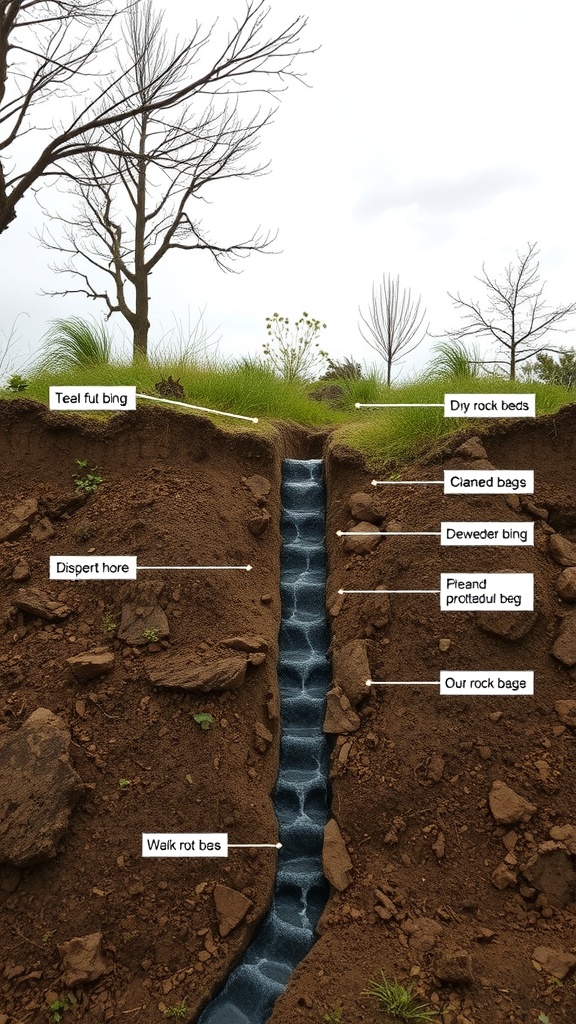
Dry rock beds are a practical solution for managing drainage in your yard. They help redirect excess water, preventing pooling and erosion. The image shows a well-structured dry rock bed, designed to guide water away efficiently.
In the picture, you can see various elements that make up this drainage system. The dry rock beds are filled with stones that allow water to flow through while filtering out debris. This setup not only looks good but also serves a functional purpose.
Notice the different layers and materials used. The clean bags and other components help maintain the structure and ensure that water moves smoothly. The pathway beside the rock bed makes it easy to access and maintain.
Creating a dry rock bed can be a fun DIY project. It involves digging a trench, adding landscaping fabric, and filling it with rocks. This not only enhances your landscape but also protects your home from water damage.
Installing a Dry Rock Bed
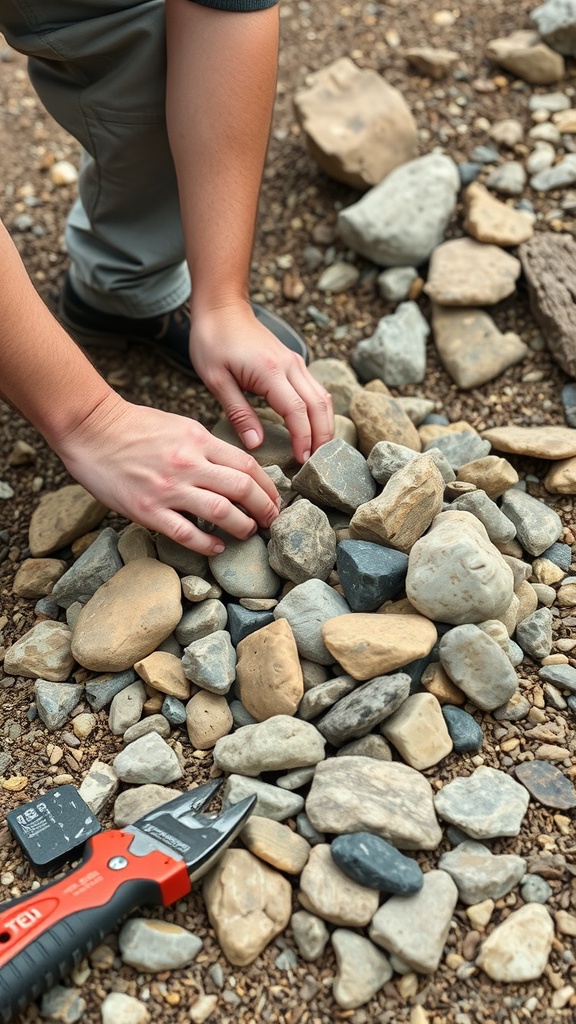
Creating a dry rock bed is a practical way to manage drainage in your yard. The image shows someone carefully arranging stones, which is a key step in this process. Using the right mix of rocks helps water flow away from areas where it can cause damage.
First, gather a variety of stones. The person in the picture is using their hands to place the rocks, ensuring they fit well together. This is important for stability and drainage. Larger stones can be used as a base, while smaller ones fill in the gaps.
Next, consider the layout. The rocks should be placed in a way that directs water away from your home or any structures. The image captures this hands-on approach, showing how thoughtful placement can make a big difference.
Finally, once the rocks are arranged, check the flow of water during a rain. This will help you see if any adjustments are needed. A well-installed dry rock bed not only looks good but also protects your landscape from water damage.
Preparing the Site for Installation
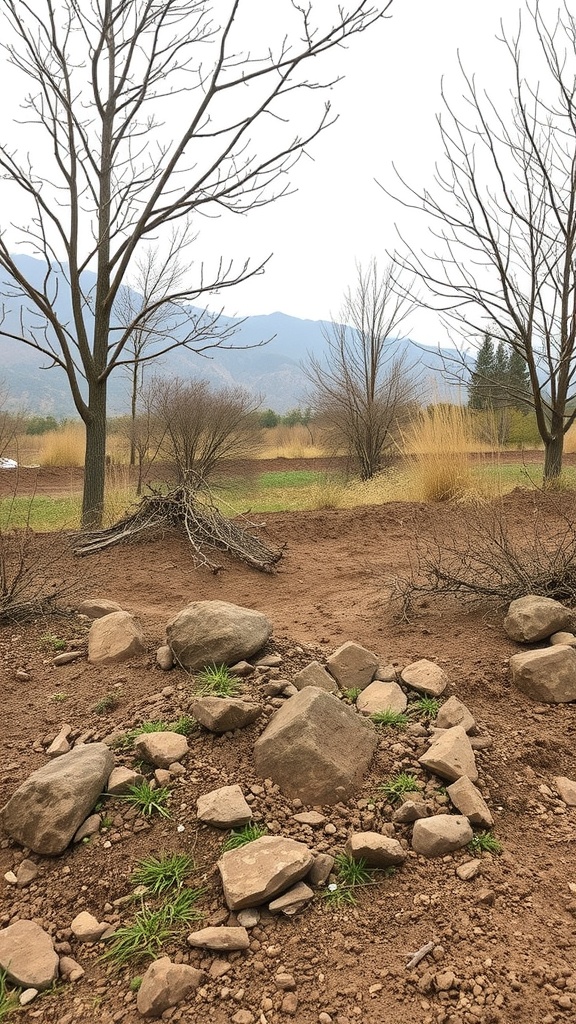
Before you start creating your dry rock bed for drainage, it’s important to prepare the site properly. The image shows a landscape with bare patches of earth and scattered rocks, which is a great starting point. You want to ensure that the area is clear of any debris, plants, or large roots that might interfere with your drainage system.
Next, assess the slope of your land. A slight slope helps water flow naturally towards the rock bed. In the image, you can see some natural contours in the land that can be utilized for effective drainage. Mark the area where you plan to install the rock bed, making sure it’s positioned to catch the water runoff.
Once you have your area marked, it’s time to dig. You’ll want to create a shallow trench where the rocks will go. This will help with water collection. The image hints at a somewhat uneven surface, which is perfect for creating a natural look. Just remember to keep the edges smooth for a neat finish.
Finally, gather your materials. You’ll need various sizes of rocks, gravel, and possibly some landscaping fabric to prevent weeds from growing through. The rocks in the image show a good mix of sizes, which is ideal for drainage. With everything ready, you’re set to create a functional and attractive dry rock bed!
Incorporating Plants into the Design
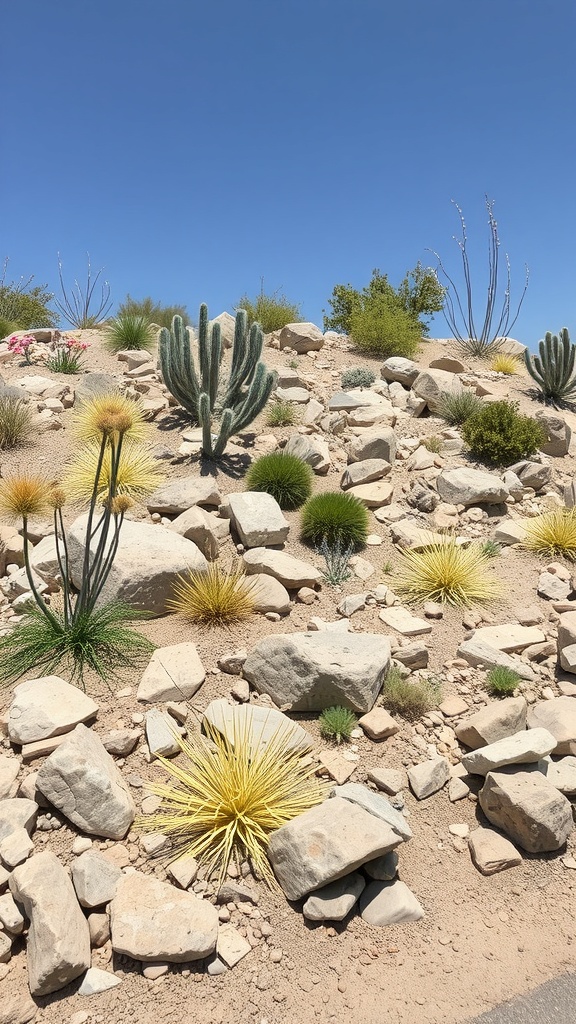
Creating a dry rock bed for drainage can be both functional and beautiful. In the image, you can see a variety of plants that thrive in arid conditions, adding life to the rocky landscape. These plants not only enhance the visual appeal but also play a role in managing water runoff.
Choosing the right plants is key. Cacti and succulents are popular choices for dry rock beds. They require minimal water and can withstand harsh sunlight. The yellow spiky plant in the foreground stands out, bringing a pop of color to the earthy tones of the rocks.
Incorporating native plants is a smart move. They are adapted to local conditions and often need less maintenance. The green tufts scattered among the rocks show how greenery can soften the hardscape while still being drought-resistant.
Arranging plants in clusters can create a more natural look. Notice how the taller cacti are grouped together, providing height and interest. This layering effect adds depth to the design and makes the rock bed more visually appealing.
Benefits of Using Dry Rock Beds
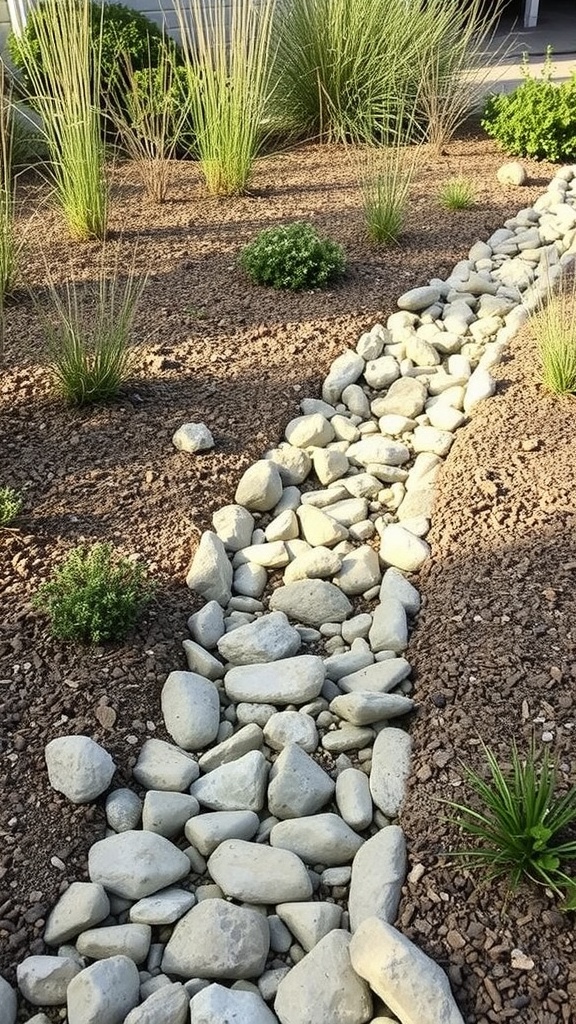
Dry rock beds are a fantastic addition to any landscape, especially when it comes to managing drainage. In the image, you can see a well-structured dry rock bed, lined with smooth stones, creating a natural path through the garden. This setup not only looks appealing but serves a practical purpose.
One major benefit of dry rock beds is their ability to control water flow. They help direct excess rainwater away from your home and other structures, reducing the risk of flooding. The rocks allow water to seep through, preventing erosion and keeping your garden healthy.
Another advantage is the low maintenance required. Once established, dry rock beds need minimal care compared to traditional gardens. The stones don’t require mowing or frequent watering, making them a great choice for busy homeowners.
Moreover, they enhance the aesthetic appeal of your yard. The contrast between the rocks and surrounding plants adds texture and interest. You can choose different sizes and colors of stones to match your style.
Lastly, dry rock beds can support local wildlife. They provide a habitat for beneficial insects and small animals, contributing to a balanced ecosystem in your garden. This natural approach to landscaping can be both beautiful and functional.
Seasonal Considerations for Dry Rock Beds
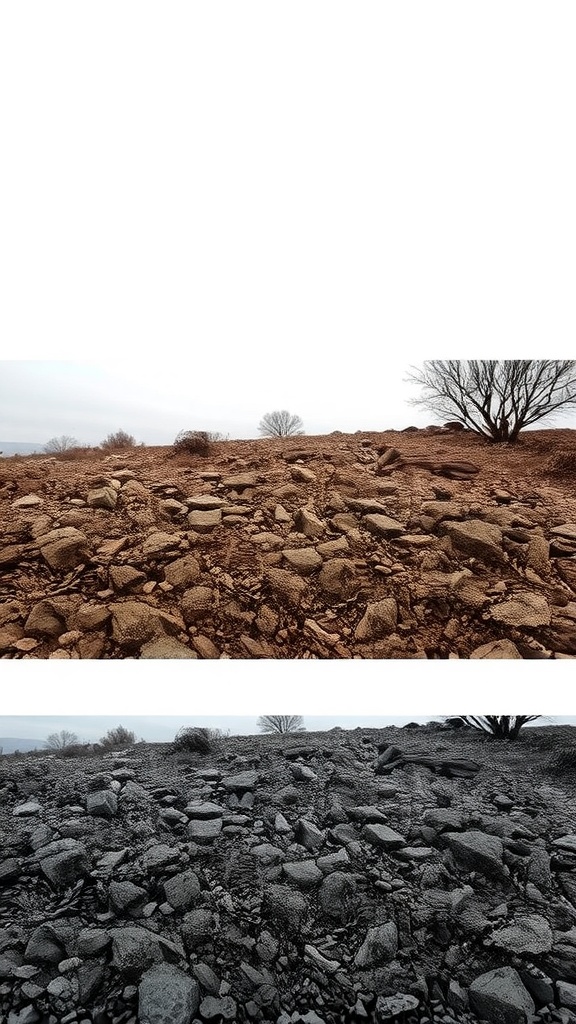
Dry rock beds are a fantastic solution for managing drainage in your yard. They not only help prevent water pooling but also add a unique aesthetic to your landscape. The image above showcases a rocky terrain, highlighting the natural beauty and functionality of a dry rock bed.
When planning your dry rock bed, think about the seasons. In spring, you might notice more rain, so ensure your rock bed can handle the increased water flow. Summer brings dry spells, making it a great time to assess how well your drainage system is working. You want to make sure that the rocks are not obstructing the flow of water.
As fall approaches, leaves can accumulate in your rock bed. Regular maintenance is key to keeping it clear and functional. Winter can be tricky too. Snow and ice might settle in the rocks, so consider how that could affect drainage. A well-placed dry rock bed can help manage melting snow effectively.
Maintaining Your Dry Rock Bed
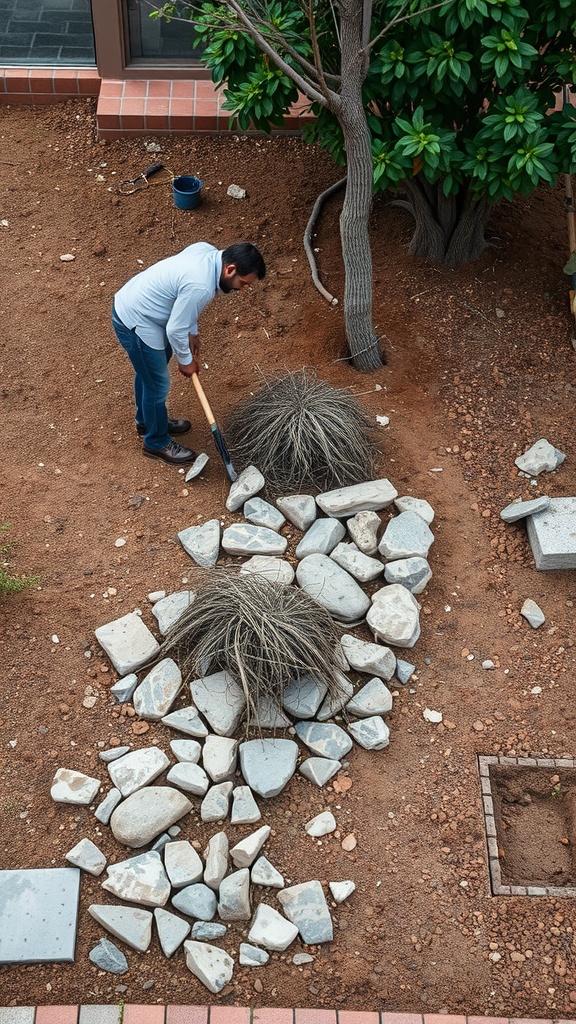
Maintaining your dry rock bed is key to keeping your outdoor space looking neat and functional. The image shows a person carefully arranging stones, which is a great way to manage drainage in your yard. Proper placement of rocks helps direct water away from your home, preventing flooding and erosion.
Regularly check for any weeds or unwanted plants that may sprout in your rock bed. Pulling them out by hand is usually the easiest method. You can also use a garden hoe to keep the area tidy. Remember, a clean rock bed not only looks good but also functions better.
Consider adding new rocks or rearranging existing ones if you notice any areas where water tends to pool. This can help improve drainage and keep your landscape looking fresh. The rocks should be placed in a way that allows water to flow freely, so keep that in mind as you work.
Lastly, don’t forget about the surrounding plants. Ensure they are healthy and not obstructing the flow of water. A well-maintained dry rock bed enhances the overall appearance of your garden while serving its purpose effectively.
Enhancing Aesthetics with Decorative Stones
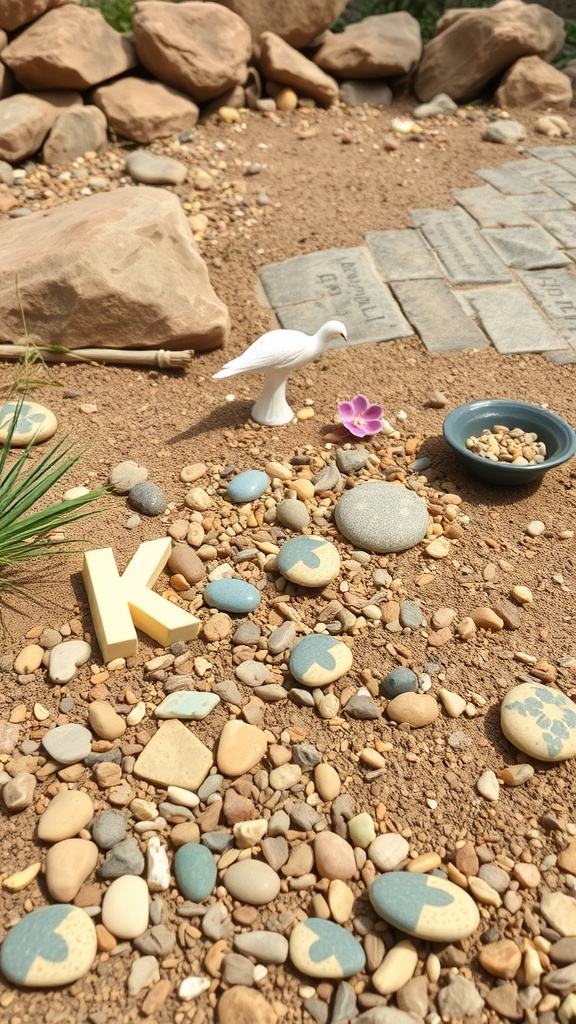
Decorative stones can completely change the look of a dry rock bed. The image shows a charming arrangement of various stones, each adding its own character. The mix of colors and shapes creates a visually appealing space that draws the eye.
Incorporating elements like a small bird figurine and a flower enhances the scene. These details make the area feel more inviting and lively. The stones not only serve a practical purpose for drainage but also contribute to the overall beauty of the landscape.
Using letters and other decorative items can add a personal touch. It’s a fun way to express creativity while maintaining functionality. This blend of aesthetics and practicality is what makes decorative stones a popular choice for outdoor spaces.
Common Mistakes to Avoid
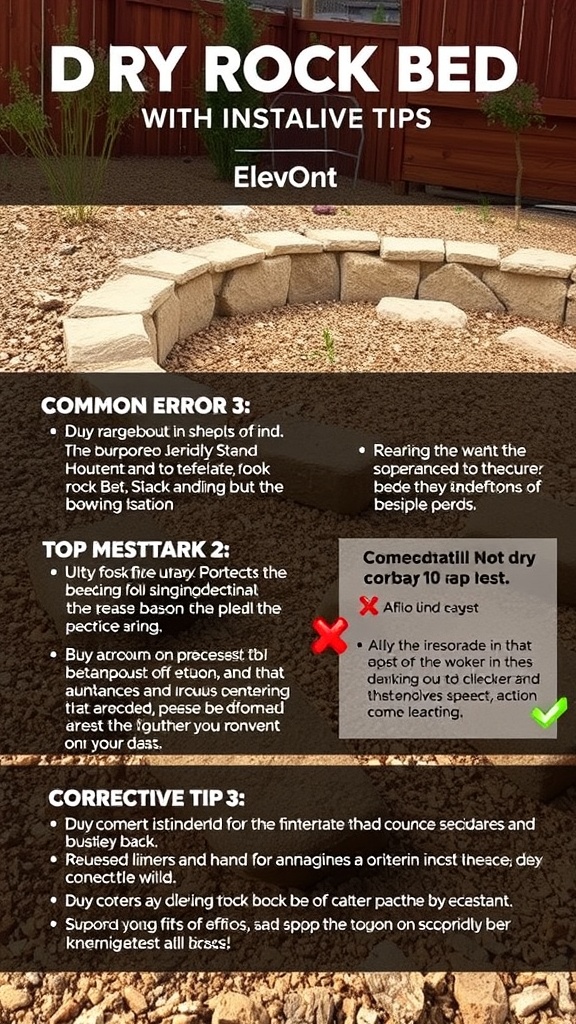
Creating a dry rock bed for drainage can be a great way to manage water flow in your yard. However, many people make common mistakes that can lead to problems down the line. One major error is not properly preparing the area before laying down the rocks. If the ground isn’t leveled or cleared of debris, it can lead to uneven drainage.
Another mistake is using the wrong type of rocks. Not all rocks are suitable for drainage. Make sure to choose rocks that allow water to flow through easily. Using the wrong materials can cause water to pool instead of draining effectively.
Lastly, neglecting to check the slope of your rock bed can be a big issue. A proper slope is essential for effective drainage. If the bed is flat, water will sit instead of flowing away. Always ensure your rock bed has a slight incline.
Using Dry Rock Beds in Sustainable Landscaping
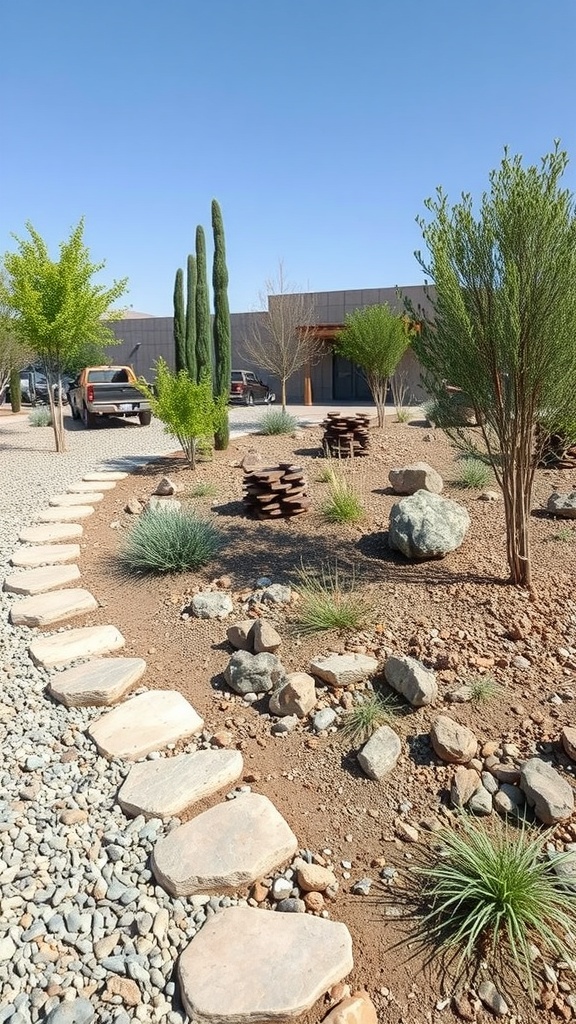
Dry rock beds are a smart choice for anyone looking to improve drainage in their landscape. The image shows a well-designed dry rock bed that blends seamlessly with the surrounding plants and stones. This setup not only looks great but also serves a practical purpose.
In the photo, you can see various plants and rocks arranged thoughtfully. The dry rock bed helps manage water runoff, allowing it to seep into the ground rather than pooling. This is especially useful in areas prone to heavy rainfall.
Using dry rock beds can also reduce the need for irrigation. The rocks and gravel absorb heat during the day, helping to keep the soil warm and encouraging plant growth. Plus, they require minimal maintenance, making them a convenient option for busy homeowners.
Overall, dry rock beds are an eco-friendly choice that adds beauty and functionality to any garden. They help create a sustainable landscape that benefits both the environment and your home.


